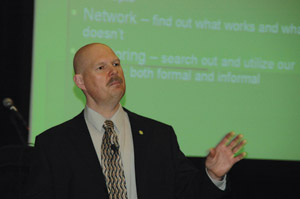
Features
Leadership
Leadership Challenges
At the Ontario Association of Fire Chiefs conference recently in Toronto, I had the privilege of co-presenting “Leadership – Art or Science,” with Deputy Chief Lyle Quan of the Guelph Fire Department.
September 17, 2008
By Les Karpluk

|
Peeling back the layers leads to manageable chunks of issues facing fire services
At the Ontario Association of Fire Chiefs conference recently in Toronto, I had the privilege of co-presenting “Leadership – Art or Science,” with Deputy Chief Lyle Quan of the Guelph Fire Department. The presentation summarized how different leadership traits affect the fire service and how fire chiefs must be tuned into the leadership game. Leadership is a balancing act and few understand what is really required from today’s leaders.
 |
Recently, while watching the movie Shrek with my five-year-old son, I had one of those light-bulb moments, which led me to what I am now calling The Shrek Layers of Leadership. Understanding another perspective on leadership while watching Shrek is not something a fire chief should readily admit! One would expect that leadership ideas come from respected authorities in the field like Ken Blanchard, Steven Covey and John Maxwell, but not a green ogre named Shrek. During a scene in the movie, Shrek explains to Donkey that an ogre is like an onion; onions have layers and ogres have layers. At this point you may wonder if I’ve lost my mind and question the relationship between Shrek, onion layers and leadership. Shrek was trying to help Donkey understand that breaking down an idea into manageable pieces (onion layers) is one way to understand a complex subject. Let’s use Shrek’s philosophy to break down two leadership challenges into manageable, bite-size pieces.
EDUCATION CHALLENGE
In 350 BC, Aristotle wrote the Nicomachean Ethics in which he stated, “The man who has been educated in a subject is a good judge of that subject, and the man who has received an all-round education is a good judge in general.” The purpose for allocating budgetary dollars to training is to equip our firefighters and officers so they are able to make sound decisions and exercise good judgment during emergency and non-emergency functions. Providing sound education and training opportunities for our future leaders equips them to be good judges in general. Aristotle had it right.

Prince Albert, Sask., Fire Chief Les Karpluk has devised The Shrek Layers of Leadership theory to break down hurdles. Like onions and ogres, leadership challenges have layers that can be peeled back and dealt with in steps.
|
The fire chief has to determine whether emphasis is to be placed on hard or soft skills. Hard skills are the minimum skills required to perform the job and include the ability to write a report, prepare a formal document, direct personnel during an emergency incident, engage a pump, etc. These are the skills that are easy to measure. The soft skills, or, as, they’re more commonly known, the people skills, are more subtle and difficult to quantify. These include the way a firefighter interacts and communicates with the public, the way an officer deals with personnel issues (conflict management), problem-solving ability, enthusiasm and the ability to give feedback and mentor. Both types of skills are essential for a leader in the fire service; both are equally important and both need to be given a priority in the profession.
There are numerous challenges in providing education and training for personnel, including time factors, seniority, scheduling issues and associated course costs (registration and possible overtime). More options are becoming available for departments to prepare staff for leadership and management positions. The virtual education world continues to advance with online certificate, degree and master programs available in a variety of business topics. These online programs are available for staff to take while on duty or in the comfort of their homes. Some post-secondary institutes offering virtual education also provide the course textbooks in PDF format, which saves the student time and money. Virtual education offers students flexibility so they can continue with their normal work schedule without attending a classroom setting. This flexibility provides the fire department with a convenient and low-cost method that helps prepare staff for those future leadership and management positions.
Without a plan, training for the sake of training is counterproductive. Let’s look at a hypothetical department that provided confined-space training five years ago, and since that time failed to implement a continuing-education program. Today, what would the result be if a member is injured while performing a confined-space rescue? My guess is that there will be potential liability issues (Bill C-45?). The education and training components in the department must be carefully planned, otherwise there is no return on the investment and the money is wasted.
THE VISION CHALLENGE
A significant challenge for today’s fire-service leader is the ability to gain followers for the vision of the department. This responsibility rests solely on the shoulders of the fire chief and it is the fire chief who must champion this call. Without a vision, without the ideal, morale falls, projects fail or do not produce the desired results and staff look for other career options.
The department and staff need direction, otherwise they will never achieve significant goals or greatness. Today’s fire service leader must continually look at the big picture, change the path when obstacles are encountered and provide a clear picture of what the department can achieve. Members of the department must be involved in creating the vision since active participation in developing the vision creates buy in from the people that have the most to gain and the most to lose.
Simply pulling staff together and asking them where they want to see the department go in the future is a great place to start. Asking for input in the development of the vision is essential for building trust. Being transparent and building relationships with the staff is one way to gain followers for the vision. Staff need to feel wanted, valued, respected and sought out for ideas before they jump on board.
JUST A THOUGHT . . .
Challenges will always exist in the fire service, just as surely as change is the norm in today’s dynamic work environment. The future of the department will only be successful when the ground has been prepared in advance. This is and will continue to be beyond the capabilities of any one individual.
In 1902 philosophical writer James Allen stated, “The vision that you glorify in your mind, the ideal that you enthrone in your heart – this you will build your life by, this you will become.” Let’s take the philosophy of James Allen, Aristotle and Shrek to develop our departments for the future; let’s become the future.
Les Karpluk, CFO, BAppBUS: ES is fire chief of Prince Albert Fire and Emergency Services. He is a graduate of the Certificate in Fire Service Leadership and Fire Service Administration programs at Dalhousie University and graduate of the Bachelor of Applied Business: Emergency Services from Lakeland College. Contact him at l.karpluk@sasktel.net.
Print this page